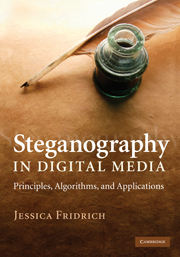Book contents
- Frontmatter
- Dedication
- Contents
- Preface
- Acknowledgments
- 1 Introduction
- 2 Digital image formats
- 3 Digital image acquisition
- 4 Steganographic channel
- 5 Naive steganography
- 6 Steganographic security
- 7 Practical steganographic methods
- 8 Matrix embedding
- 9 Non-shared selection channel
- 10 Steganalysis
- 11 Selected targeted attacks
- 12 Blind steganalysis
- 13 Steganographic capacity
- A Statistics
- B Information theory
- C Linear codes
- D Signal detection and estimation
- E Support vector machines
- Notation and symbols
- Glossary
- References
- Index
- Plate section
8 - Matrix embedding
Published online by Cambridge University Press: 05 April 2014
- Frontmatter
- Dedication
- Contents
- Preface
- Acknowledgments
- 1 Introduction
- 2 Digital image formats
- 3 Digital image acquisition
- 4 Steganographic channel
- 5 Naive steganography
- 6 Steganographic security
- 7 Practical steganographic methods
- 8 Matrix embedding
- 9 Non-shared selection channel
- 10 Steganalysis
- 11 Selected targeted attacks
- 12 Blind steganalysis
- 13 Steganographic capacity
- A Statistics
- B Information theory
- C Linear codes
- D Signal detection and estimation
- E Support vector machines
- Notation and symbols
- Glossary
- References
- Index
- Plate section
Summary
In the previous chapter, we learned that one of the general guiding principles for design of steganographic schemes is the principle of minimizing the embedding impact. The plausible assumption here is that it should be more difficult for Eve to detect Alice and Bob's clandestine activity if they leave behind smaller embedding distortion or “impact.” This chapter introduces a very general methodology called matrix embedding using which the prisoners can minimize the total number of changes they need to carry out to embed their message and thus increase the embedding efficiency. Even though special cases of matrix embedding can be explained in an elementary fashion on an intuitive level, it is extremely empowering to formulate it within the framework of coding theory. This will require the reader to become familiar with some basic elements of the theory of linear codes. The effort is worth the results because the reader will be able to design more secure stegosystems, acquire a deeper understanding of the subject, and realize connections to an already well-developed research field. Moreover, according to the studies that appeared in [143, 95], matrix embedding is one of the most important design elements of practical stegosystems.
As discussed in Chapter 5, in LSB embedding or ±1 embedding one pixel communicates exactly one message bit. This was the case of OutGuess as well as Jsteg.
- Type
- Chapter
- Information
- Steganography in Digital MediaPrinciples, Algorithms, and Applications, pp. 135 - 166Publisher: Cambridge University PressPrint publication year: 2009



